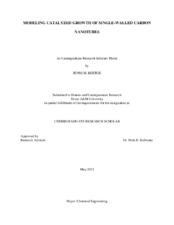| dc.creator | Beetge, Jenni Mignon | |
| dc.date.accessioned | 2015-09-03T15:25:10Z | |
| dc.date.available | 2015-09-03T15:25:10Z | |
| dc.date.created | 2013-05 | |
| dc.date.issued | 2013-02-27 | |
| dc.date.submitted | May 2013 | |
| dc.identifier.uri | https://hdl.handle.net/1969.1/154898 | |
| dc.description.abstract | ABSTRACT
Modeling Catalyzed Growth of Single-Walled Carbon Nanotubes. (May 2013)
Jenni M. Beetge
Artie McFerrin Department of
Chemical Engineering
Texas A&M University
Research Advisor: Dr. Perla B. Balbuena
Artie McFerrin Department of
Chemical Engineering
Single walled carbon nanotubes (SWCNT’s) are in high demand due to their wide range of applications. However, many applications are reserved for pure chirality SWCNT’s because of the difference in properties associated with the twisting of the structure. Currently there are conflicting theories regarding the synthesis mechanism of SWCNT’s. Understanding the effects of key parameters of SWCNT growth during chemical vapor deposition may enable manipulation of the process to produce SWCNT’s with the desired chirality. This research project presents the results of classical molecular dynamics modeling of SWCNT nucleation and growth, focusing on the effects of nanoparticle-support interaction and precursor type on the chirality of the nanotube. Using SIMCAT, a reactive force field code, simulations are run for pure Ni nanoparticles with two types of carbon containing C2 precursor gas, each having five different support interaction energies, for three nanoparticle sizes. The same parameters were studied for different compositions of Ni and Co in bimetallic nanoparticles. The simulation results are used to visually examine the nucleation and growth processes as well as quantitatively determine statistics regarding carbon species inside and on the nanoparticle surface. The visualization results reflected the effects of kinetic and thermodynamic driving forces that cause surface diffusion to dominate after carbon atoms filled the nanoparticle core through bulk diffusion. From the results we were also able to determine the probability curves and charts of carbon chain formation inside the nanoparticle and the hexamer and pentamer count on the nanoparticle surface. Analysis of these results suggests that carbide formation is not necessarily a prerequisite for carbon nanotube growth, which is one mechanism under debate. Furthermore, the nanoparticles displayed liquid-like solid behavior. While nanotube quality was hindered by the formation of bamboo growth due to strong metal-support interaction, higher quality nanotubes were observed for cases involving C2 precursor gas. | en |
| dc.format.mimetype | application/pdf | |
| dc.subject | Nickel nanocatalyst | en |
| dc.subject | Ni-Co bimetallic nanocatalyst | en |
| dc.subject | carbide formation | en |
| dc.subject | annealing effect | en |
| dc.subject | nanoparticle-support interaction | en |
| dc.subject | quality | en |
| dc.title | Modeling Catalyzed Growth of Single-Walled Carbon Nanotubes | en |
| dc.type | Thesis | en |
| thesis.degree.department | Chemical Engineering | en |
| thesis.degree.discipline | Chemical Engineering | en |
| thesis.degree.grantor | Honors and Undergraduate Research | en |
| dc.contributor.committeeMember | Balbuena, Perla B | |
| dc.type.material | text | en |
| dc.date.updated | 2015-09-03T15:25:10Z | |


